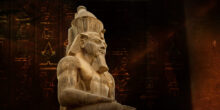Khufu

The kings of the Fourth Dynasty were known for building the pyramids to serve as tombs for them after their death, so Khufu built his pyramid, like his father Snefru, who built three pyramids, and like Djoser.
The life of King Khufu
King Khufu is the son of King Snefru, who founded the Fourth Dynasty, and Queen Hetepheres, the daughter of one of the kings of the Third Dynasty, Khufu succeeded his father Snefru, therefore he is the second king of the Fourth Dynasty.
Khufu’s reign
Egypt, during the period in which Khufu seized power, was facing challenges and difficulties, the most important of which was that in the Sinai region there were armed gangs intruding on the country, not only they were violent, but they were forcing the Bedouins in this region to help them, which affected the trade movement that was taking place between Egypt and the Levant region, and the operation of searching and excavating for precious stones in Wadi al-Maghara was hindered. Therefore, King Khufu did everything to eliminate these gangs, so he sent armies after them until they were expelled outside the country and managed to secure the borders of the country, which led to some historians stating that he was the first Egyptian king to communicate directly with the Babylonian kingdom in order to secure the area that lies between them and Egypt, and also led to the people of Nubia stopping any rebellious movement and accepting to be under Egyptian sovereignty.
King Khufu, during his reign, was trying to preserve the borders of the country and secure it internally, and trying to preserve what his father, King Senefru, the founder of the Fourth Dynasty, established.
King Khufu was famous during his life for his many marriages, and therefore he had many children, all of whom were prepared by their mothers to inherit the throne, so, in order to avoid the predictable conflict after his death, Khufu set laws for the throne:
- The heir shall be a son of the king and his sister, “which was common at the time.”
- The mother of the heir shall be a queen.
- If the first and second conditions are not met, and the heir is the son of an ordinary woman, but on the condition that he be strong and worthy of judgment and that he marry one of the women of the royal family and her blood is royal.
Despite establishing these laws, divisions arose among Khufu’s sons, the matter ended with his son (Djedefre) assuming power, and this son was not the one who met the specifications of the legal heir, but the son who was to inherit power disappeared in mysterious circumstances, not only he assumed power but Djedefre also married his sister, who was a wife of his brother, who was to inherit the throne, and disappeared, and he did this in order to be less suspicious, many of his other brothers also died in mysterious circumstances, and Djedefre was succeeded by his brother Khafre.
Pyramid of Khufu
The kings were building Pyramids to be tombs for them and their belongings after their death, but instead of Khufu building the pyramid in the Saqqara or Dahshur area, he moved the construction area to the Giza plateau, thinking that the height of this area would bring him closer to the sky and the sun disk that represents the god Ra, this area is also close to Heliopolis, which is seat of the cult of the god Ra, and the stones that were found in the Giza plateau were commensurate with the stones that they would use in building the pyramid, thus it would be easier for the workers to transport the stones to the construction site.
The process of building the pyramid was undertaken by the genius engineer “Hemiunu”, who, after completing the construction of the pyramid in a period of nearly twenty years, was appointed as the first minister of King Khufu.
The Great Pyramid or the Pyramid of Khufu is known as one of the world’s Seven Wonders. It was built from a number of limestone stones, which numbered approximately 2,300,000, the weight of each stone was approximately 2.5 tons, bringing the weight of the Great Pyramid as a whole to 6 million tons. The base of the pyramid was 227.5 meters long and 137 meters high, so that the size of the pyramid was approximately 2,500,000 m³. Most of the workers who carried out the construction work were farmers who were gathered during the Nile River flood period to occupy themselves with construction work as compensation for the period of interruption of their work during the flood.
The pyramid of Khufu was built with the highest degree of accuracy, and its designs and measurements were chosen with specific indications and objectives and not randomly, which is still to this day a source of admiration for the whole world and evidence of the ability, intelligence, greatness and creativity of the ancient Egyptian.
The death of King Khufu
Historical sources did not mention information explaining how King Khufu died, as his mummy has not been found yet. It is believed that it has been buried in a secret place, or that there are secret entrances or undiscovered rooms in which the king may have been buried.





